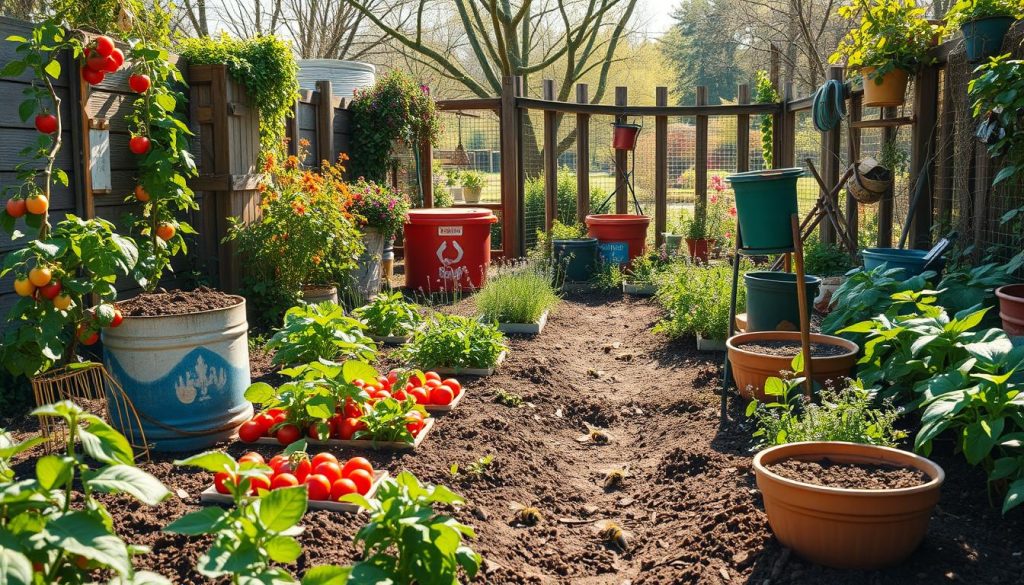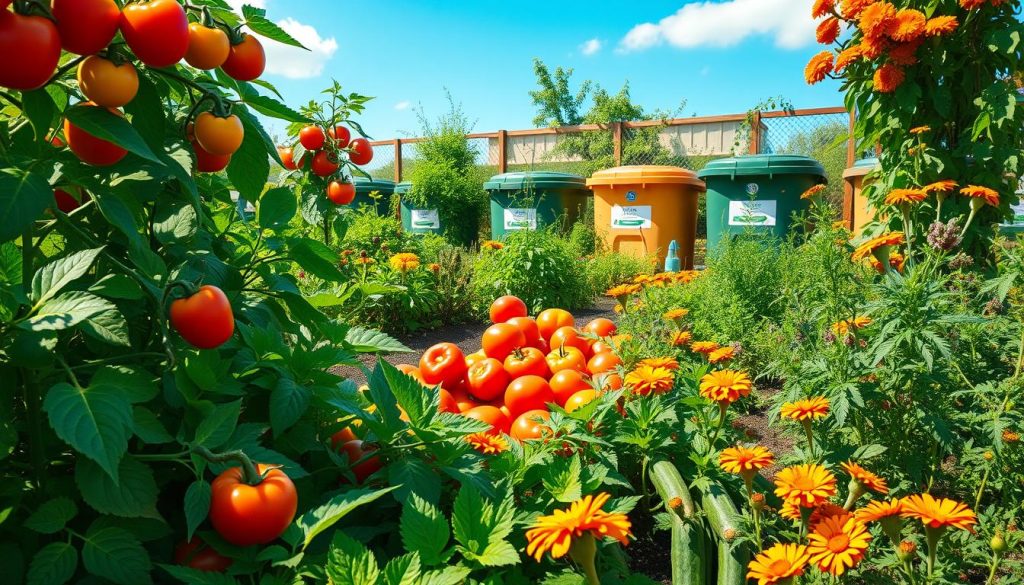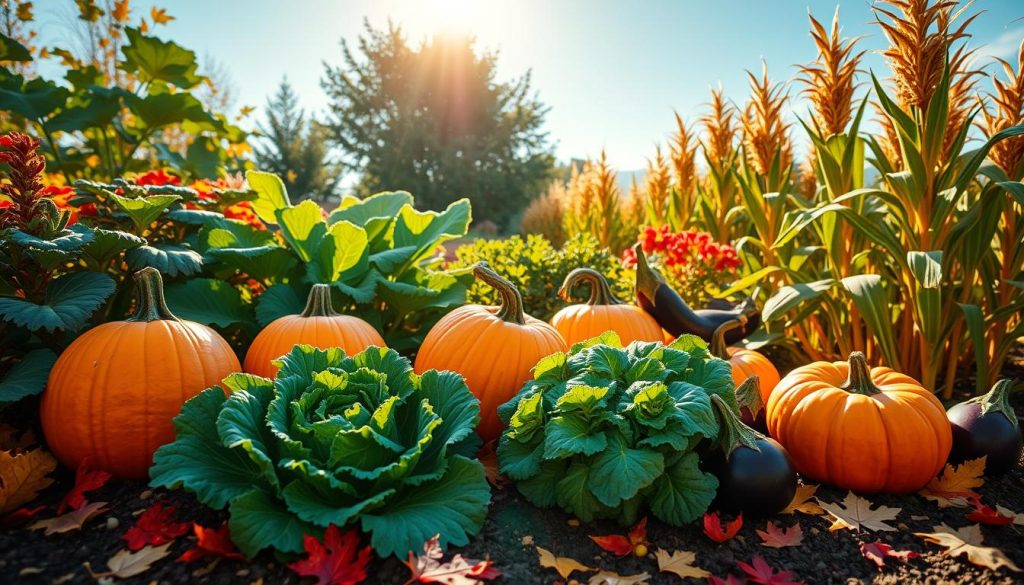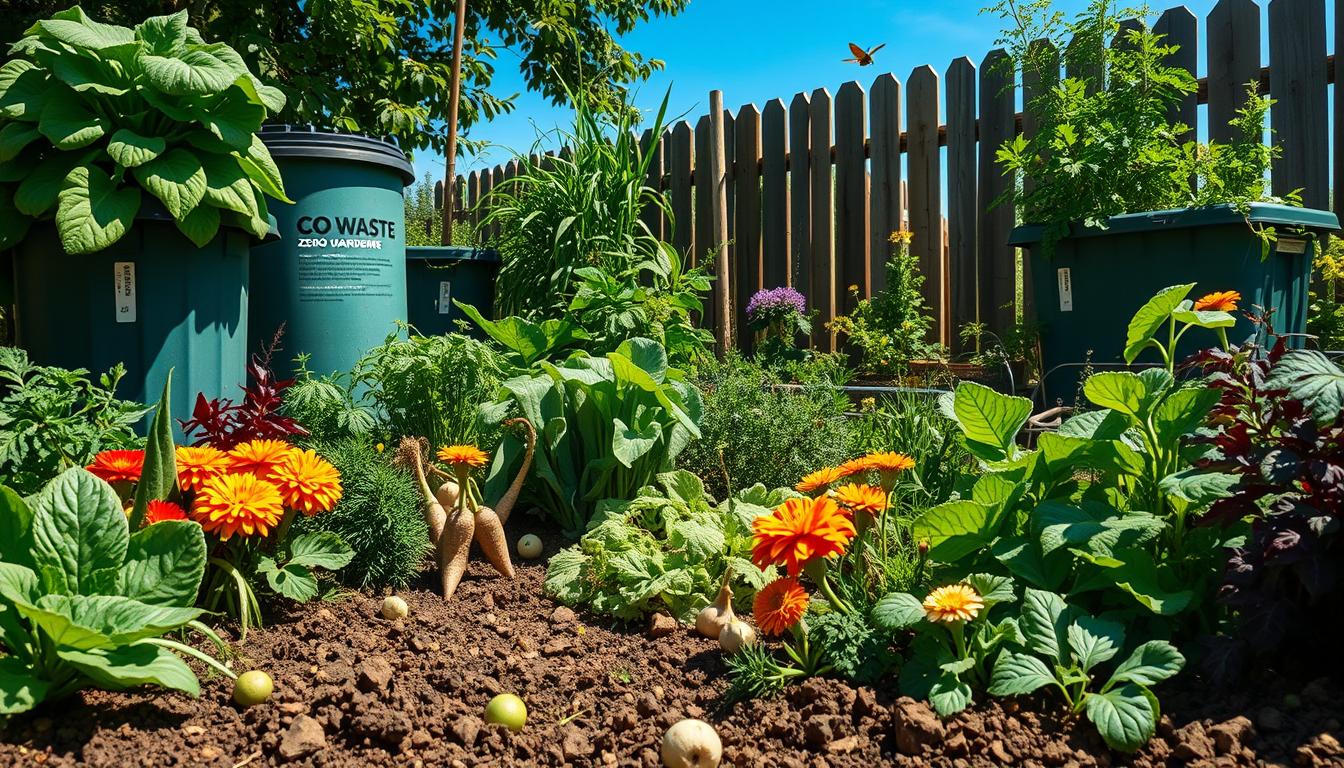I’m excited to share my experience with zero-waste seasonal gardening. I focus on the best crops for a sustainable garden. By using organic gardening methods and eco-friendly plants, we can reduce our environmental impact.
Choosing the right crops for each season has made a big difference. I’ve found that a sustainable garden not only gives us fresh produce but also helps the local ecosystem. I’m eager to share my knowledge to help others create their own sustainable gardens.
Understanding Zero-Waste Gardening Principles
As I explore gardening, I’ve learned the value of sustainable practices. These practices help reduce waste and protect our environment. Zero-waste gardening is key here, aiming for a system where nothing is wasted. By using zero-waste tips and a seasonal guide, gardeners can grow plenty while supporting sustainable farming.
Zero-waste gardening focuses on reducing, reusing, and recycling. This method cuts down waste and makes gardening more effective. Important steps include:
- Composting kitchen scraps and yard waste to create nutrient-rich soil
- Using rainwater collection systems to reduce water waste
- Implementing crop rotation and companion planting to minimize the need for fertilizers and pesticides
By following these steps and a seasonal guide, gardeners can build a sustainable garden. This garden will not only grow fresh food but also help the environment. I’m eager to share my journey and inspire others to join the sustainable gardening movement.
Best Crops for Spring Season
As the weather gets warmer, it’s time to pick the best crops for spring. Natural plant cultivation is essential for environmentally friendly farming. We can make our gardens sustainable and productive with waste-free gardening techniques. Let’s look at three top crops for spring: leafy greens, radishes, and peas.
Leafy Greens: A Quick Harvest Delight
Leafy greens are perfect for spring gardens. They grow fast and can be harvested quickly. You can grow lettuce, kale, and spinach using natural methods. These crops are great for the environment because they need little waste and can grow in many conditions.
Radishes: Fast-Growing and Versatile
Radishes are another excellent choice for spring. They grow quickly and are versatile in cooking. You can use them in salads, soups, and more. By gardening waste-free, we can make our gardens more sustainable.
Peas: Delicious and Nutrient-Rich
Peas are delicious and packed with nutrients, making them ideal for spring gardens. They grow fast and can be ready in about 50 days. Adding peas to our gardens makes them more sustainable and environmentally friendly. 
Some benefits of these crops include:
- Quick growth rate
- Versatility in cooking
- High nutrient content
- Low waste production
By choosing these crops and using eco-friendly farming, we can have a thriving garden. It will give us a rich harvest.
Sustainable Practices for Growing Crops
As I keep working on my zero-waste garden, I’ve learned how vital sustainable practices are. Organic gardening focuses on cutting down waste and using eco-friendly plants. These methods help us lessen our environmental footprint and make our ecosystem healthier.
Here are some ways to do this:
- Composting kitchen scraps to create nutrient-rich soil
- Using crop residues and waste to cut down landfill waste
- Practicing companion planting for pest management, which reduces the need for chemical pesticides
By adding these sustainable practices to our gardening, we make our agriculture more eco-friendly. This is good for the environment and helps our plants grow strong and healthy. It also cuts down on waste.
Best Crops for Summer Season
As summer gets closer, it’s key to pick crops that love the heat. By using zero-waste gardening tips and a seasonal guide, you can grow a lot of food. Some top summer crops are:
Tomatoes: Rewarding and Flavorful
Tomatoes are a summer favorite. They need the right care to grow well. Using compost and crop rotation helps them grow without waste.
Zucchini: High Yield and Nutrient Dense
Zucchini is great for summer. It’s full of nutrients and good for many dishes. Planting it at the right time makes it healthy and strong.

Herbs: A Flavor Boost with No Waste
Herbs like basil and mint add flavor without waste. They can be grown without harming the environment. Harvesting them often keeps them fresh and flavorful.
Harvesting and Storing Your Produce
As I explore natural plant cultivation, I’ve learned the value of proper harvesting and storage. These steps help reduce waste and support sustainable agriculture. I’ve found that using waste-free gardening techniques leads to a bigger harvest and less environmental impact. Here, I’ll share my tips on harvesting and storing your produce, helping you maximize your zero-waste gardening.
Timing is key when it comes to harvesting. Regular checks and picking at the peak of ripeness ensure the best taste and texture. This way, I avoid waste by picking my leafy greens in the morning for salads or as a side dish.
To keep my produce fresh, I use various storage methods like refrigeration, freezing, and dehydrating. These methods help maintain the quality and nutritional value of my harvest. I enjoy my homegrown produce all year long. Some of my top storage tips include:
- Refrigerating leafy greens and herbs to keep them fresh for up to a week
- Freezing berries and other fruits to use in smoothies and baked goods
- Dehydrating vegetables, such as tomatoes and zucchini, to make crispy snacks
By following these natural plant cultivation and waste-free gardening tips, you can cut down on waste and support sustainable agriculture. Always check on your plants, harvest at the right time, and use efficient storage to enjoy your produce fully.
Best Crops for Fall Season
As the weather cools down, it’s time to think about the best crops for the fall season. Organic gardening is a great way to grow delicious and nutritious food while reducing waste. By choosing eco-friendly plants, you can create a sustainable garden that benefits both you and the environment.
Root Vegetables: Ideal for Cooler Weather
Root vegetables like carrots, beets, and turnips are perfect for fall gardening. They are hardy, versatile, and can thrive in cooler weather. With zero-waste gardening tips, you can reduce food waste and make the most of your harvest.
Kale: Nutritious and Resilient
Kale is another great crop for fall gardening. It’s nutritious, resilient, and can be used in a variety of dishes. By incorporating kale into your garden, you can create a sustainable and eco-friendly space that produces a bountiful harvest.

Pumpkins: Perfect for Fall Recipes
Pumpkins are a classic fall crop that can be used in a variety of recipes. They are easy to grow, nutritious, and can be used to create delicious dishes such as pumpkin pie and soup. By following zero-waste gardening tips, you can reduce food waste and make the most of your pumpkin harvest.
Incorporating Native and Heirloom Plants
Exploring zero-waste gardening has shown me the value of native and heirloom plants. They help with environmentally friendly farming and support sustainable agriculture. This approach also promotes natural plant cultivation.
Benefits of Planting Native Varieties
Planting native varieties helps preserve biodiversity and supports local ecosystems. These plants are well-suited to the local climate and soil. They need less care, which helps reduce my environmental impact.
By choosing native plants, I create a garden that thrives. It also benefits the local wildlife.
Heirlooms: Preserving Biodiversity
Heirloom plants are another excellent choice for gardeners. They have been passed down through generations. Their unique traits and flavors add value to any garden.
Growing heirloom plants helps preserve biodiversity. It also supports sustainable agriculture practices.
How to Source Native and Heirloom Seeds
To start with native and heirloom plants, I can find seeds locally or online. Local nurseries, seed libraries, and online retailers are good sources. They focus on sustainable agriculture and natural plant cultivation.
Choosing the right seeds helps me create a garden that’s both productive and environmentally friendly. It supports environmentally friendly farming practices.
Final Thoughts on Zero-Waste Gardening
Reflecting on my gardening journey, I’m deeply grateful for zero-waste gardening. It lets me grow a healthy garden with minimal waste. This approach also helps reduce my impact on the environment.
Sharing what I’ve learned with others is very important to me. Together, we can make a big difference in our gardens. I urge you to keep learning about zero-waste gardening. With some effort, you can enjoy its many benefits too.

